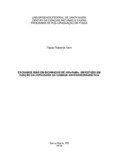| dc.creator | Kern, Paula Roberta | |
| dc.date.accessioned | 2019-04-18T18:50:57Z | |
| dc.date.available | 2019-04-18T18:50:57Z | |
| dc.date.issued | 2018-12-04 | |
| dc.identifier.uri | http://repositorio.ufsm.br/handle/1/16267 | |
| dc.description.abstract | The exchange bias (EB) arises, generally, from the interfacial coupling between a ferromagnetic
layer (FM) and an antiferromagnetic layer (AFM). The most well-known manifestations
of this phenomenon, in samples with a FM/AFM interface, are the field shift in the magnetization
curves and the increase in the coercive field when compared to the uncoupled
FM material. Many experimental results have shown that the exchange bias field (Heb) and
coercivity (HC) in FM/AFM bilayers are inversely proportional to the FM layer thickness. On
the other hand, the relationship between these parameters and the AFM layer is more complicated
and the particularities of each system will define how the evolution of Heb and HC
with the AFM thickness will be. The general rule is that there exists a critical thickness of the
AFM below which the EB vanishes. In this thesis, in order to investigate the emergence and
evolution of EB as a function of the AFM layer thickness, NiFe(50 nm)/FeMn(tAFM) bilayers
were produced with 3 nm tAFM 30 nm. The work was carried out by means of structural
and magnetic characterization techniques, such as X-ray reflectivity and diffraction,
magnetometry and ferromagnetic resonance (at a fixed frequency and broadband). The
results obtained by static and dynamic magnetic characterization have shown that, for this
FM/AFM system, the EB arises when tAFM 6 nm. A description of the angular evolution
of the ferromagnetic resonance field, considering the Zeeman, demagnetization, uniaxial,
unidirectional and rotatable energies, confirmed the existence of a misalignment between
the uniaxial and unidirectional anisotropies axes, which was found to be dependent on the
AFM layer thickness. In addition, the evaluation of the ferromagnetic resonance linewidth as
a function of temperature, performed for two samples, presented a peak at approximately
75 K, which was interpreted in terms of inomogeneities in the samples. | eng |
| dc.description.sponsorship | Coordenação de Aperfeiçoamento de Pessoal de Nível Superior - CAPES | por |
| dc.language | por | por |
| dc.publisher | Universidade Federal de Santa Maria | por |
| dc.rights | Attribution-NonCommercial-NoDerivatives 4.0 International | * |
| dc.rights.uri | http://creativecommons.org/licenses/by-nc-nd/4.0/ | * |
| dc.subject | Exchange bias | por |
| dc.subject | Ressonância ferromagnética | por |
| dc.subject | Desalinhamento | por |
| dc.subject | Largura de linha | por |
| dc.subject | Anisotropia | por |
| dc.subject | Temperatura | por |
| dc.subject | Ferromagnetic resonance | eng |
| dc.subject | Misalignment | eng |
| dc.subject | Linewidth | eng |
| dc.subject | Anisotropy | eng |
| dc.subject | Temperature | eng |
| dc.title | Exchange bias em bicamadas de NiFe/FeMn: um estudo em função da espessura da camada antiferromagnética | por |
| dc.title.alternative | Exchange bias in NiFe/FeMn bilayers: a study as a function of the antiferromagnetic layer thickness | eng |
| dc.type | Tese | por |
| dc.description.resumo | O exchange bias (EB) surge, comumente, do acoplamento interfacial entre uma camada
ferromagnética (FM) e uma camada antiferromagnética (AFM). As duas manifestações
mais bem conhecidas desse fenômeno, em amostras com uma interface FM/AFM, são
o deslocamento em campo das curvas de magnetização e o aumento da coercividade
quando comparada à do material FM desacoplado. A maior parte dos resultados experimentais
tem mostrado que os campos de exchange bias (Heb) e coercivo (HC) de bicamadas
FM/AFM são inversamente proporcionais à espessura da camada FM. Por outro
lado, a relação entre esses parâmetros e a camada AFM é mais complicada, sendo que
as particularidades de cada sistema definirão como será a evolução de Heb e HC com a
espessura AFM. A regra geral é que existirá uma espessura AFM crítica abaixo da qual o
EB desaparecerá. Nessa tese, com o objetivo de investigar o aparecimento e a evolução
do EB em função da espessura da camada AFM, foram produzidas bicamadas de NiFe(50
nm)/FeMn(tAFM) com 3 nm tAFM 30 nm. O trabalho foi realizado por intermédio de
técnicas de caracterização estrutural e magnética, tais como difração e refletividade de
raios-X, magnetometria e ressonância ferromagnética (com frequência fixa e banda larga).
Os resultados encontrados por meio da caracterização magnética estática e dinâmica mostraram
que, para esse sistema FM/AFM, o EB surge quando tAFM 6 nm. Uma descrição
feita para a evolução angular do campo de ressonância ferromagnética, considerando a
energia Zeeman e as energias de anisotropias magnetostática, uniaxial, unidirecional e
rodável, confirmou a existência de um desalinhamento entre os eixos das anisotropias uniaxial
e unidirecional, o qual se revelou dependente da espessura da camada AFM. Além
disso, a avaliação da largura de linha da ressonância ferromagnética em função da temperatura,
realizada para duas amostras, apresentou um pico em, aproximadamente, 75 K, o
qual foi interpretado em termos de inomogeneidades nas amostras. | por |
| dc.contributor.advisor1 | Carara, Marcos André | |
| dc.contributor.advisor1Lattes | http://lattes.cnpq.br/1334485128053939 | por |
| dc.contributor.referee1 | Denardin, Juliano Casagrande | |
| dc.contributor.referee1Lattes | http://lattes.cnpq.br/5425237044575885 | por |
| dc.contributor.referee2 | Viegas, Alexandre Da Cas | |
| dc.contributor.referee2Lattes | http://lattes.cnpq.br/5936503285330202 | por |
| dc.contributor.referee3 | Oliveira, Artur Harres de | |
| dc.contributor.referee3Lattes | http://lattes.cnpq.br/5413344891000141 | por |
| dc.contributor.referee4 | Silva, Leandro Barros da | |
| dc.contributor.referee4Lattes | http://lattes.cnpq.br/2500664315353832 | por |
| dc.creator.Lattes | http://lattes.cnpq.br/7337023805392903 | por |
| dc.publisher.country | Brasil | por |
| dc.publisher.department | Física | por |
| dc.publisher.initials | UFSM | por |
| dc.publisher.program | Programa de Pós-Graduação em Física | por |
| dc.subject.cnpq | CNPQ::CIENCIAS EXATAS E DA TERRA::FISICA | por |
| dc.publisher.unidade | Centro de Ciências Naturais e Exatas | por |



